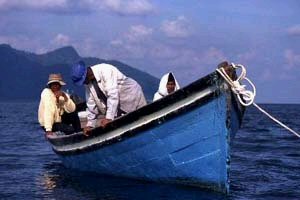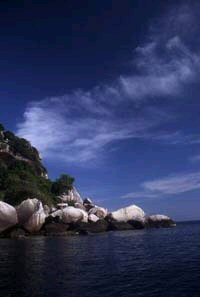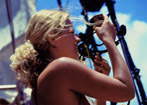| |
Exploration of the islands off peninsular Malaysia's east coast inclding a science study at Pulau Renggis, Tioman
March 24 - June 9, 2001
| Mar 24 |
Depart Raffles Marina, Singapore |
| Mar 25 |
Arrive Pulau Tioman, Malaysia |
(150 miles) |
02° 49.79' N |
104° 09.08' E |
| Mar 29 |
Arrive Pulau Tulai |
(7 miles) |
02° 54.78' N |
104° 05.95' E |
| Apr 1 |
Arrive Juara, Pulau Tioman |
(16 miles) |
02° 47.14' N |
104° 12.52' E |
| Apr 3 |
Arrive Bahara Rock |
(16 miles) |
02° 40.25'N |
104° 03.66' E |
| Apr 3 |
Return to Pulau Tioman |
| Apr 10 |
Arrive Pulau Tenggol |
(120 miles) |
04° 48.35' N |
103° 40.78' E |
| Apr 17 |
Arrive Pulau Redang |
(74 miles) |
05° 44.65' N |
103° 00.88' E |
| Apr 22 |
Arrive Pulau Lima |
(5 miles) |
05° 46.54' N |
103° 03.15 E |
| Apr 24 |
Arrive Pulau Perhentian Besar |
(26 miles) |
05° 53.32' N |
102° 40.29' E |
| Apr 26 |
Arrive Pulau Susu Dara Besar |
(5 miles) |
05° 57.12' N |
102° 40.29' E |
| Apr 29 |
Return to Pulau Lima |
(27 miles) |
| May 1 |
Return to Pulau Redang |
(5 miles) |
| May 5 |
Return to Pulau Tioman |
(198 miles) |
The Heraclitus received a warm send-off from the dock of Raffles Marina and a welcome return to the open sea with dolphins gathering at her bow. Negotiating the chaos of the shipís traffic in the Straits was no easier than on arrival, especially trying to cross the channel at Horsborough Lighthouse in the middle of the night! But the following day they arrived at the foothills of Pulau Tioman, approaching the island and its magnificent southern face at dusk and anchoring in the bay at night. After almost two months out of the water, there was a race among the crew to get diving again. They explored the wrecks in the bay and the fishlife at the jetty where the marine park headquarters are.
Almost two weeks were spent more in the water than out of it, soaking up the magnificent dive sites in the area like Chebeh, Tiger Rock, Bahara Rock, anchoring in beautiful bays at Tulai, north west of Tioman, and Juara on its east side. All the while the crew were on the lookout for a suitable site to carry out a science study, and finally decided that the reef around the small island of Pulau Renggis in the western bay of Tioman was ideal. The ship itself got some attention with repairs to the rigging after the ravages of the South China Sea crossing.

The Heraclitus headed to Pulau Tenggol, the next patch of islands 120 miles to the north. The crew were forced to be on the lookout the whole way for fishing buoys and passing trawlers with extremely long nets behind them, a great threat to our propellor. As they approached Tenggol, dolphins took over as look-outs for these obstacles and guided the ship through a slalom course of fishing stakes. The ship anchored safely in front of the island from where the crew could watch large rays leaping on the surface, listen to the deafening sounds of the jungle and watch the full moon rise above them. They spent a week diving at magical sites with strong currents which meant anything was possible. The weather became changeable and the currents were unpredictable - this is not necessarily an easy place to dive but it is incredibly interesting. Some of the crew made friends with the fishermen who offered gifts of squid, rays and heaps of small fish while others explored the island, its trees and insects and listened to the sounds of the monkeys.
After a week in the Tenggol area and the return of Sam Birch, second mate and the shipís Scientific Coordinator, the crew were ready to move on to dive sites new. Pulau Redang was 74 miles to the north and its ring of islands provided one of the most beautiful anchorages for the Heraclitus. Tourism has taken a deep root here with large resorts, golf courses, and communities of sea-people being relocated to the islandís hills to make space for more hotels. The island next door, Pulau Penang, has become a marine park centre. Its reefs are reserved for the daytrippers who float in their orange lifejackets and feed the fish with plastic bread, and on land there is a centre of information on reefs and turtles especially. Some of the crew joined a school-trip for a night on a beach watching a turtle hatch her eggs into a sandy nest. The fishermen in Redang hauled their nets very close to the beach, definitely within the supposed no-fishing zone - and they make a splendid catch of jacks, longtoms, mackerel. The diving found a focus at a sea mount, just off Pulau Lima, hard to find since its pinnacle was about 15 metres deep, where there were sharks, giant groupers, schools of fat jacks and great barracudas.
Two of the crew took a trip to the mainland, to Terengganu, to explore the connection between Malays and the sea - their traditional techniques for boat building still preserved on Pulau Duyong, their fishing methods described fully at the Museum, and their bounty for sale along with vast arrays of fruits and vegetables in a bustling market which fed both stomach and mind.
The Heraclitus headed north again, to the Perhentians, the end point of this east coast cruise where they encountered the backpacker crowd who have made this a firm fixture on their South-East Asian odysseys. The crew based themselves a little further from the action, at Pulau Susu Dara Besar, close to the best dive site in the area by far - Tokong Laut. Itís a steep pinnacle that creeps above the surface to make a small rock island and below the crashing waves lies an underwater playground for barracuda, baby nurse sharks, blue spotted ribbontail rays, fusiliers, groupers, clouds of damselfish, pufferfish and porcupine fish. Every morning at least 30 dive boats would come from Perhentian Besar to drop at least 150 divers into the water. The crew of the Heraclitus had the luxury of choosing their own dive times, avoiding the rush hour.
There were encounters with the larger wildlife of Malaysia here at Susu Dara - the crew tried to help a struggling sea eagle who had been attacked and badly injured by another bird. He willingly took a ride in the inflatable boat as they tried to bring him safely to land but there was no way of knowing if he would survive the ongoing dive-bombs of the other angry bird. Some divers also surfaced one day at Tokong Laut to hear reports of a thirty foot whaleshark that had passed close by to them but they werenít lucky enough to see it unfortunately.
At the end of the April, the ship turned around and began to retrace its steps southwards. They stopped at Redang and Lima again to make last dives at their favourite sites and then settled in Telok Tekek, the bay on the west side of Tioman which was to be home for the next five weeks. During this time the shipís mission was to carry out an intense science study at the island of Renggis, the crew diving there constantly until they were able to draw a map of their reef from memory! Itís a small but very beautiful reef, in excellent condition considering it was bombed badly up until about five years ago. Itís made a good recovery and the only signs of damage now are those inflicted by a large storm two years ago. There is a family of fat black tip sharks living there, turtles, mullets, and many beautiful reef fish. There are huge fields of almost pristine corals - montipora, echinopora, acropora, some enormous porites heads. Between dives, the crew explored the island of Tioman, its forests and trails and monkeys and monitor lizards, making friends with the islandís people, learning their foods, their cultures.

All the while the Heraclitus gathered a small reef of her own on the hull with barnacles that clung like cement. When the time came to move off again, her systems were sluggish, possibly feeling neglected after being stationary for what seemed like a long time. But the crew pooled their technical know-how to repair the weak points, and on the June 9th set sail eastwards for Sarawak, a journey of 420 nautical miles to discover what remains of Borneoís rainforests and traditions, wildlife and longhouses.
|
|










